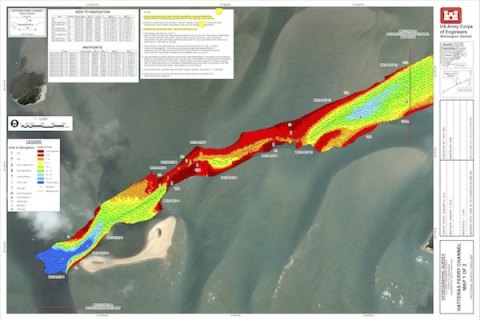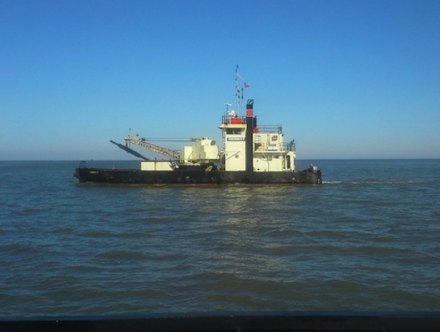Dredging Up Disappointment
“We are still planning on running the alternate route,” said Jed Dixon, deputy director of the NCDOT ferry division. “With the Corps’ current funding they will not be able to dredge enough to make the channel safe for us to use.”
The sidecaster dredge Merritt was sent by the Army Corps of Engineers to work at Hatteras Inlet last week, but it had to take a break because of weather and an “all-hands meeting” with the Corps. The Merritt will start dredging again on Friday, working 8 – 10 days total, and when they’re done, they’re done. This dredging project will exhaust the last bit of money allocated in the Federal budget for Hatteras Inlet until October 1st.
The dredging will focus on the trouble spot by marker 14, and between markers 9 – 12, in order to get Rollinson channel (the “short route”) open for fishing boats and the US Coast Guard boats that use the inlet. It will also make it easier for the ferries to turn into the Barney Slough (the “long route”), but they will still be making that turn. No one expects the ferries to go back to the short route anytime soon.
So this is good news for the Hatteras Island charter and commercial fishermen who depend on the inlet for their livelihood. And it’s good news for the Coast Guard when they need to get out the inlet quick for a search-and-rescue. But it won’t help Ocracoke residents and visitors get here any faster.
“Unless there are significant changes in natural inlet conditions or increased funding for dredging, we anticipate the use of Barney's Slough for Ferry traffic,” confirmed Hank Heusinkveld at the Wilmington Army Corps of Engineers office.
Hyde County manager Bill Rich attended a meeting last week with boat captains and the USCG on Hatteras Island, who, he said, are “really passionate about keeping the short route open.” Bill said they talked about the budget for the inlet and their hope that more money can be allocated for dredging.
“I’m not very encouraged by any of it,” Bill said. “The Corps is out of money, and the [current] dredging is just a little band-aid.”
What’s really needed is a major dredging effort that would use the sand to build up the southern end of Hatteras Island.
“The amount of real estate that has eroded is amazing,” Bill said. “The only way we can get the short route back is if we replenish the Hatteras side of the inlet.”
As Hatteras Island washes away, the shifting sands also threaten Ocracoke’s current. (That is, the electric kind of current, not your favorite news source – we’re going strong!). Ocracoke’s power comes from a substation near the Hatteras ferry landing, runs along power poles, then goes underwater across the inlet, then comes back up again at Ocracoke and along power poles down Highway 12 to the Tideland substation on Ocracoke and then to our homes and businesses. (Just ponder that for a minute; it’s pretty amazing.)
Rudy Austin is on the Tideland EMC board and is also president of Ocracoke Civic and Business Association. He reported at last week’s OCBA meeting that Tideland’s management is concerned about our power source because of the erosion at Hatteras.
“The overwash is coming under the power poles,” Rudy explained. “A thousand feet of our power lines are where the dunes are washing away.”
Rudy said that Tideland recently made improvements to the poles to help them withstand both hurricanes and ice storms, but they may have to spend more money to move them.
I asked Hank at the Corps of Engineers about using the dredge spoil to build up the end of Hatteras Island, but it’s not going to happen this time.

“The Corps currently has permits to place material in near shore disposal areas immediately north (Southern tip of Hatteras Island) and south (Northern portion of Ocracoke Island) of Hatteras Inlet,” he told me. “However, near shore placement will not occur during this dredging cycle. Current conditions necessitate the use of the side-cast dredge Merritt; therefore, dredge spoil will be deposited in the waterway, outside of the channel, in a manner that the spoil is least likely to return to the channel.”
95% of the channel's problem shoaling is in the area under the jurisdiction of the Federal government. Where the state has jurisdiction, they are able to keep the channel dredged.
"The last time the channel was dredged to the maximum width and depth of 100 feet wide and 10 feet deep, the Corps spent $3.5 million, and it lasted 45 days," Jed Dixon said at the January 12th ferry division public meeting.
In order to dredge a wider channel and build up the south end of Hatteras Island, "the Feds would have to change the legislation," Jed said.
"Dredging is never-ending," said Harold Thomas, the other deputy ferry division director. "We'd need a dredge there 365 days a year to keep the channel open."
(The dredge Merritt costs about $15,000/day. That would be about $5.5 million a year. The Federal budget has allocated funds of just $550,000 this year for Hatteras Inlet. That money will all be spent by next week.)
Given that they don't expect the short route to be open for ferry traffic anytime soon, the ferry division is considering passenger-only ferries (more on that in another story….). Ocracoke residents and visitors can list pros and cons of passenger ferries, but the biggest worry is that the advent of passenger ferries will lead to the state giving up the fight for the short route.
At the ferry division public meeting, Ocracoke resident Vince O'Neal said, "We can't lose focus on the traditional ferry run. It's a matter of politics and money. We've got to keep pressure on government agencies to work on that inlet and shore up our power supply."
Meanwhile, Oregon Inlet is also shoaling, and is, as Bill Rich put it, “so critical and so close to being closed.”
Congressman Walter B. Jones has recently asked the Corps to allocate more funding for Oregon Inlet. His January 22nd press release included this quote:
“The maintenance of the Oregon Inlet is vital to the economic success of Eastern North Carolina,” said Congressman Jones. “Fishermen, recreational boaters and the Coast Guard must have reliable access through the inlet, and I will continue to do everything I can to fight for that cause.”
Perhaps our elected representatives need to hear more from us about Hatteras Inlet.
Or…. we can all hope for a big hurricane to clear away the sand from Hatteras and Oregon Inlets without damaging the road or bridge or villages. It could happen!




